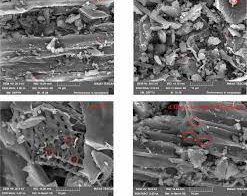Chromium is widely present in the leather processing process, but it should only be the trivalent one, less harmful to humans and the environment. However, it is sometimes found as a production residue resulting from the treatment of sludge produced from tannery waste. A study on the thermochemical decomposition of oily sludge experiments with how to mitigate pollution and obtain charcoal-like substance known as Biochar, which can improve carbon sequestration and soil fertility. [Removal of Cr(VI) by biochar derived via co-pyrolysis of oily ... - Nature]
With the acceleration of industrial development, the overuse of landfills, and the stacking of domestic garbage, large amounts of heavy metals enter rivers and lakes through sewage systems1. These heavy metals have been reported to bioaccumulate and express biotoxic characteristics2 since they are easily transported through the biological chain, endanger human health and the ecosystem, and cause large-scale pollution3. Chromium (Cr) is a significant industrial material used for production in many industries, such as leather tanning 4. These industries produce large amounts of Cr-containing wastewater. Without proper disposal, these toxic substances severely harm ecosystems and give rise to numerous diseases5. Therefore, Cr has been listed as a priority pollutant in many countries. Cr(III) and Cr(VI), which have different mobilities and carcinogenicities, are the dominant forms of Cr in aqueous solutions6. Owing to its strong solubility, mobility, and toxicity, Cr(VI) has extremely teratogenic and carcinogenic effects on humans and animals7. Therefore, it is essential to control the concentration of Cr(VI) in wastewater to protect ecosystems and human health.
The co-pyrolysis of oily sludge with biomass to prepare carbon materials is not only an effective way to mitigate oily sludge pollution, but it is also a method of obtaining carbon materials. In this study, a carbon material (OS-CS AC) was obtained by the direct co-pyrolysis of oily sludge (OS) and corn stalks (CS) and then applied to Cr(VI) removal. According to the hydroxy and carboxy masking experiments and the characterization of OS-CS AC by FT-IR, SEM, XPS, XRD, and N2 physical adsorption–desorption, Cr(VI) can be adsorbed efficiently through pore filling, the surface oxygen-containing functional groups can promote the reduction of Cr(VI) to Cr(III) through electron donors, and the greater the electrostatic attraction between the electron-donating functional groups of OS-CS AC and the Cr(VI) is, the stronger the ability to remove Cr(VI). In addition, the removal process was discussed, and the results indicated that the McKay kinetic model, Langmuir isotherm model and Van't Hoff thermodynamic model were the most suitable models for removal. The main factors affecting the removal of Cr(VI) were discussed, and the removal of Cr(VI) reached 99.14%, which gives a comprehensive utilization way of oily sludge and corn stalks.
-------------
The authors are Lei Han, Jinling Li, Tiantian Zhang, Chengtun Qu, Tao Yu, Bo Yang and Ziguo Shao, published in scientific reports volume 12, Number 9821 (2022) Study (link)


